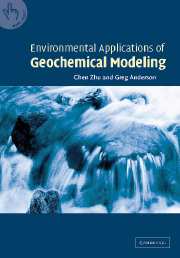Book contents
- Frontmatter
- Contents
- Preface
- 1 Introduction
- 2 Model Concepts
- 3 Thermodynamic Background
- 4 Computer Programs for Geochemical Modeling
- 5 Preparation and Construction of a Geochemical Model
- 6 Speciation and Solubility Modeling
- 7 Modeling Surface Adsorption
- 8 Reaction Path Modeling
- 9 Inverse Mass Balance Modeling
- 10 Coupled Reactive Transport Models
- 11 Kinetics Modeling
- Appendix
- References
- Index
3 - Thermodynamic Background
Published online by Cambridge University Press: 27 March 2010
- Frontmatter
- Contents
- Preface
- 1 Introduction
- 2 Model Concepts
- 3 Thermodynamic Background
- 4 Computer Programs for Geochemical Modeling
- 5 Preparation and Construction of a Geochemical Model
- 6 Speciation and Solubility Modeling
- 7 Modeling Surface Adsorption
- 8 Reaction Path Modeling
- 9 Inverse Mass Balance Modeling
- 10 Coupled Reactive Transport Models
- 11 Kinetics Modeling
- Appendix
- References
- Index
Summary
Geochemical modeling programs are built, for the most part, on the fundamental laws of thermodynamics and kinetics. In this chapter we introduce the subject of equilibrium thermodynamics. Kinetics is dealt with in Chapter 11.
Although it is not necessary to be able to derive all the relationships used in modeling from first principles, it is necessary to have a reasonable understanding of the meanings of the terms used. These are, of course, derived and discussed in innumerable textbooks on the subject (e.g., Anderson, 1996; Anderson and Crerar, 1993), but they can be difficult to find in the large amount of material covered, or difficult to understand in the context of natural or environmental systems. An attempt is made here to present the fundamental principles in a reasonably intuitive way, omitting some tedious derivations. We begin by presenting definitions of the essential concepts.
Systems and Equilibrium
Real and Model Systems
In a complete treatment of thermodynamics, systems are divided into various types, the details of which we can safely neglect here. But there is one point about systems that we should not neglect, and that is that thermodynamic systems and real systems are two different things.
The aim in performing geochemical modeling (or in fact most kinds of modeling) is to learn something about some natural system. In environmental problems, the “natural system” is normally at some geographic location, has dimensions of some hundreds of meters horizontally and perhaps some tens of meters vertically, and is made up of rocks, soils, and fluids in various combinations. We want to understand what processes are occurring in the system, and to predict the future state of the system.
Information
- Type
- Chapter
- Information
- Environmental Applications of Geochemical Modeling , pp. 32 - 73Publisher: Cambridge University PressPrint publication year: 2002
